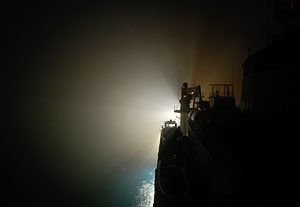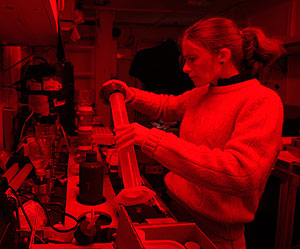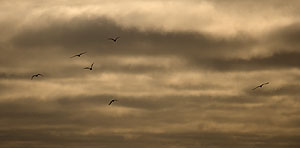|
|
 |
 |
Science
Crew Facts

For the past three years
Jim Johnson has been involved in a project called the North
Pole Environmental Observatory. He lived in a camp on
an ice floe near the North Pole for about 10 days each April. He is also a whiz at origami. |
Daily Update
Calendar
Dispatch 08 - September 8, 2004
By C. A. Linder
Weather conditions: Partly cloudy skies, 15 kt winds, 2-3 ft
seas, air temperature 36° F
Into the Deep
The thick fog was an eerie sight as
I photographed science activities well into the night. Spotlights
on the two A-frames lit up the blowing mist as it swirled around the
stern of the ship. I was soaked by the time I finally made it back
to my room for some sleep.
 |
 |
| A ghostly light from the science operations filters through the fog. |
Click to enlarge
|
When I arrived in the main lab the next morning I discovered that
the morning had already started off with a bit of excitement. Anna
Nikolopoulos told me all about an incredible encounter that the morning
watch team had with some Arctic wildlife...
Anna recalls: "Walrus!" It was Seth waking us up
from our day-dreaming during the early-morning shift in the lab. His
word made us move faster than light, put on gloves, hats, and jackets
and quickly go out to the aft; we had visitors! A walrus mum with
her baby made circles around the boat and the towed multi-net that
was running from the A-frame. Such an amazing sight! Free, so close,
and for a long time, they swam around us, mum tightly followed by
her little one. Sometimes they remained in one spot, observing us,
while walrus mother seemed to hold the baby
in her arms...animal motherhood isn't that different from ours
I guess! Did they look for food? Or, were they just curious? Was this
perhaps the kiddie's first lecture in "how to act when meeting a ship"?
I don't know, but this sure was a beautiful odd morning to remember,
and who knows, maybe the walruses think the same?!"
 |
 |
| Ellen Naughter
measures Arctic seawater into a graduated cylinder in the chlorophyll
van. Red light is used to stop the concentration of chlorophyll
from changing. |
Click to enlarge
|
 |
 |
| A flock of kittiwakes has been following the ship. |
Click to enlarge
|
By late morning the lingering fog had burned off, replaced by thick
billowing clouds, pockets of sun, and a cold wind. We are still
methodically working our way northward over a steep submarine cliff
into ever deeper water. The seafloor is now more than a mile below
us.
It was another busy day for the aviation detachment. One of the helicopters
delivered some Healy crew members to the town of Barrow,
but while landing a rock became airborne and cracked the windshield
so badly that it was unsafe for the pilots to fly back to the ship.
Thick fog and sleet in Barrow prevented the second Dolphin from bringing
out the spare until later in the day. Finally, when the weather improved
the second helicopter brought out the spare and returned to the ship.
In the midst of the flight operations, a fire
drill was conducted onboard.
While we have been slowly sampling with our lowered
instruments today, the WHOI moored instruments below us have been
making their robotic journey through the water column four times a
day. Up and down the moored profilers have crawled, recording the
temperature, salinity, and currents faster than we ever could with
a ship. Little do they know that tomorrow their work will be done,
and they will be brought out of the water and back onto the ship.
Bob Pickart is hoping that those moorings have been faithfully logging
every little change in the seawater since last year. In the next few
days we will find out - stay tuned!

|
Traducido al Español por Andrea |
En lo profundo
La gruesa niebla hacia raro el paisaje mientras fotografiaba al grupo científico en sus actividades nocturnas. Los dos focos en la grúa daban cuenta como la creciente bruma se arremolinaba alrededor de la popa del barco. Estaba empapado para cuando pude volver a mi cuarto a dormir un rato.
Cuando, a la mañana siguiente, llegue al laboratorio principal a descubrí que el ambiente estaba un poco alterado, Anna Nikolopoulos me describió el increíble encuentro que tuvieron en el turno de la mañana con la vida salvaje del Ártico...
Anna nos contó:
“¡Morsas!” Fue Seth quien nos llamó la atención cuando se nos caían los ojos en el turno a buenas horas de la madrugada. Sus palabras nos hicieron mover mas rápido que la luz, nos pusimos los guantes, gorros y chaquetas y corrimos rápido a popa; ¡teníamos visitantes! Una morsa madre y su bebe daban vueltas alrededor del barco mientras estábamos remolcando la multired. ¡Una visión maravillosa! Libres, tan cerca y por un buen rato nadaron alrededor de nosotros, mientras que la madre parecía coger a su pequeño entre sus brazos...el instinto maternal no es tan distinto al nuestro, supongo.
¿Estarían buscando comida? ¿O era simplemente curiosidad? O quizá era la primera lección para la cría de “como actuar cuando te encuentras con un barco”. No se la respuesta, pero seguro que esta va a ser una buena mañana para recordar, pude que para las morsas también.
A medida que avanzaba la mañana la niebla se fue disipando y reemplazando por bajas nubes, huecos de sol y frío viento. Seguimos nuestro trabajo metodológicamente hacia el norte sobre el acantilado submarino sobre aguas cada vez mas profundas. El fondo esta ahora a mas de una milla (¡2000m!).
Fue otro día atareado para el destacamento de aviación. Uno de los
helicópteros tuvo que llevar a un miembro de la tripulación del Healy
a la ciudad de Barrow, pero tuvieron problemas al aterrizar ya que
una roca fisuro la luna de tal manera que era peligroso para que los
pilotos volvieran al barco. La gruesa niebla y algo de nieve en Barrow
impidieron que el segundo Dolphin saliera a recogerlos hasta entrada
la tarde. Al final, cuando el tiempo mejoro el segundo helicóptero
pudo traer la pieza de repuesto y volver al barco. En medio de las
operaciones de vuelo la tripulación llevo a cabo un
simulacro de emergencia.
Mientras nosotros muestreamos tranquilamente con nuestros instrumentos a bordo, los instrumentos anclados en el fondo de WHOI han estado tomando muestras robóticamente cuatro veces al día. Arriba y abajo los instrumentos anclados se arrastran, grabando la temperatura, salinidad y corrientes mas rápido que lo que nunca podríamos conseguir con un barco. No saben que su trabajo termina mañana y van a ser recogidos del agua de vuelta al barco. Bob Pickart espera que los “moorings” (instrumentos anclados) hayan captado con éxito todos los cambios en el agua de mar durante este ultimo año. Estos próximos días lo sabremos, estad atentos.
 Previous
Dispatch
Next Dispatch Previous
Dispatch
Next Dispatch

Back to Calendar
|
|




